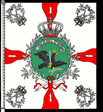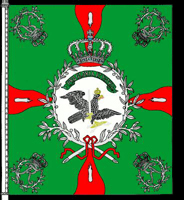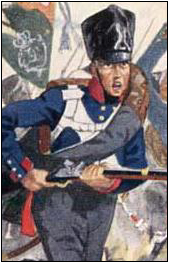

Preußische Heeresbibliothek
(Preußische Armee Library)

A short history of Prussia's
1st West Prussian Infantry Regiment,
Numbered "6" in the line.
Oberstlieutenant Dallas Gavan
2. Westpr. IR Nr. 7
I Korps
Königlich Preußische Armee
Re-formed after the debacle of 1806/7, the 1st West Prussian Infantry Regiment was also known as Infantry Regiment Number 6. In German the title was Erstes Westpreußisches Infanterie-Regiment Nummer 6 (abbreviated as "1. Westpreuß IR Nr 6").
The musketeer battalions of 1. Westpreuß IR Nr 6 were raised as the "Füsilier-Regiment v. Langfeld Nr 52" on 4 April 1773. This regiment took part in the 1794 invasion of Poland, seeing service at Rawka and Warsaw. In 1806 the regiment was brought up to strength for the war against France, fighting at Dirschau before withdrawing into the fortress at Danzig. It was distinguished by its service in the siege of Danzig (where LT von Hanstein and LT von Hanemann were awarded the Orden Pour le Merit) and when the regiment was used to form the grenadier companies and musketeer battalions of 1. Westpreuß IR Nr 6, the new regiment retained the colours of the old.
Fusilier Battalion von Wakenitz Nr 3 became the Fusilier Battalion when 1. Westpreuß IR Nr 6 was formed in 1808. This fusilier battalion was originally raised as a garrison company in 1714. In 1787 it was reformed as a fusilier battalion under Major von Thiele. The battalion also served in the Polish campaign, seeing action at Modlin and Stanislavova (where the unit captured 500 Polish troops and two guns). It saw action in 1806/7 at Biezun, Waltersdorf, Braunsberg and Königsberg before the survivors gathered at Baumwalde after the treaty of Tilsit.
In 1808 these units were combined to form 1. Westpreuß IR Nr 6, with the standard organisation for a Prussian infantry regiment of the time. It had two grenadier companies (detached to the West Prussian Grenadier Battalion, later the 2nd Battalion of the 2nd Grenadier Regiment "Kaiser Franz"), two musketeer battalions and one fusilier (light infantry) battalion. From 1813 a company of volunteer rifles (Freiwilliger Jäger) was also attached.
In 1812 the regiment provided its 1st musketeer battalion to form the 5th Combined Regiment by amalgamation with battalions from 2. Westpreuß IR Nr 7. It saw action against the Russians at Dahlenkirchen, Kiopen and Linden (where it captured a Russian battalion of 400 men and Major von Stechow was awarded the Orden Pour le Merit). The regiment returned to Prussia under the Treaty of Tauroggen in early 1813.

Leibfahne (or 1st Battalion's colour)
In early 1813 the regiment fought as both part of the "5th Combined Infantry Regiment" and as the 2. Westpreuß IR Nr 7, the regiment's 2nd Reserve Battalion taking the place of the 1st Musketeer Battalion in the line. The 1st battalion of the regiment, still part of the "5th Combined Infantry Regiment", fought at Danikow, Königswartha and Bautzen. The regiment's other battalions were engaged at Gross Görschen and Bautzen (where the 2nd Musketeer and Fusilier battalions lost 219 men).
On 10 August 1813 the regiment's battalions were recombined and it took to the field as part of 10 Brigade, II Armee Korps. In the coming year it would fight at Dresden, Kulm (where the Fusilier Battalion captured a General and 350 enemy), Wachaw and finally Leipzig, where the regiment sustained 857 casualties.
In 1814 the regiment fought at Thionville, Montmirail, Chateau-Thierry and Laon, where the regiment captured four cannon and a howitzer. The regiment was part of the force that entered Paris, forcing Napoleon's first abdication.
In 1815 the regiment fought at Charleroi, Marchienne au Pont and Ligny (where the regiment lost 13 officers and 474 men) as part of 2 Brigade in I Korps. At Villers-Cotterets the fleeing French were caught and 14 cannon and 20 ammunition wagons were captured from them.
The regiment won the following decorations from 1808:
1 Order Pour le Merit ("Blue Max")
1 Order of the Red Eagle 3rd Class
19 Iron Cross 1st Class
182 Iron Cross 2nd Class
10 Military Commendations 2nd Class

Regimentsfahne (or 2nd Battalion's colour)
After the Napoleonic Wars the regiment was redesignated the 1st West Prussian Grenadier Regiment in 1860. The regiment was destroyed on the Western Front in World War 1.

A musketeer of the 4th company, 1st Battalion, attacking the Great Gardens at Dresden.
(From Knötel)


Site Maintained by Scott Ludwig
E-mail: Eric2900@aol.com
© 2004-present